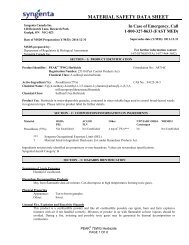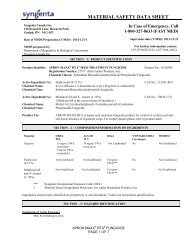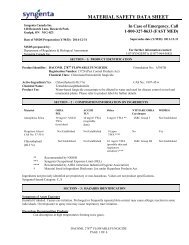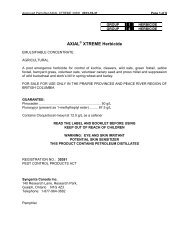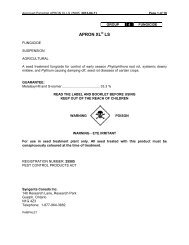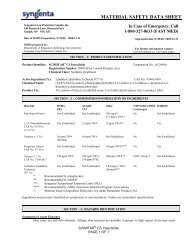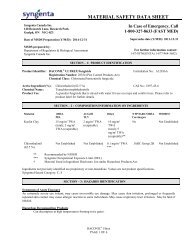Bonzi MSDS - Syngenta Crop Protection
Bonzi MSDS - Syngenta Crop Protection
Bonzi MSDS - Syngenta Crop Protection
- No tags were found...
You also want an ePaper? Increase the reach of your titles
YUMPU automatically turns print PDFs into web optimized ePapers that Google loves.
MATERIAL SAFETY DATA SHEET<strong>Syngenta</strong> Canada Inc.140 Research Lane, Research ParkGuelph, ON N1G 4Z3Date of <strong>MSDS</strong> Preparation (Y/M/D): 2014-12-31In Case of Emergency, Call1-800-327-8633 (FAST MED)Supersedes date (Y/M/D): 2011-12-31<strong>MSDS</strong> prepared by:Department of Regulatory & Biological Assessment<strong>Syngenta</strong> Canada Inc.SECTION – 1: PRODUCT IDENTIFICATIONFor further information contact:1-87-SYNGENTA (1-877-964-3682)Product Identifier: ACTIGARD ® 50WGRegistration Number: 29756 (Pest Control Products Act)Chemical Class: A plant growth activator.Formulation No.: A9180AActive Ingredient (%): Acibenzolar-S-Methyl (50.0%) CAS No.: 135158-54-2Chemical Name: S-methyl 1,2,3-benzothiadiazole-7-carbothioateProduct Use:Please refer to product label for further details.SECTION – 2 : COMPOSITION/INFORMATION ON INGREDIENTSMaterialDiatomaceous Earth(CAS No. 61790-53-2)OSHAPEL80mg/m³/%SiO 2 (20 mppcf)TWAACGIHTLV10 (inhalable);3 mg/m³(respirable)TWAOtherNTP/IARC/OSHA WHMIS†Carcinogen6 mg/m³ TWA ** IARC 3 Not EstablishedAcibenzolar-S-Methyl(50.0%)Not Established Not Established 10 mg/m³TWA***NoNot Established** Recommended by NIOSH*** <strong>Syngenta</strong> Occupational Exposure Limit (OEL)† Material listed in Ingredient Disclosure List under Hazardous Products Act.Ingredients not precisely identified are proprietary or non-hazardous. Values are not product specifications.<strong>Syngenta</strong> Hazard Category: B, S.Symptoms of Acute ExposureMay cause skin irritation.Hazardous Decomposition ProductsNone known.SECTION – 3: HAZARDS IDENTIFICATIONPhysical PropertiesAppearance:Odour:Light brown to dark brown granules.Moderate, sulphurous-like.Unusual Fire, Explosion and Reactivity HazardsDuring a fire, irritating and possibly toxic gases may be generated by thermal decomposition or combustion.ACTIGARD ® 50WGPAGE 1 OF 6
Relevant routes of exposure: Skin, eyes, mouth, lungs.SECTION – 4: FIRST AID MEASURESIF POISONING IS SUSPECTED, immediately contact the poison information centre, doctor or nearest hospital. Havethe product container, label or Material Safety Data Sheet with you when calling <strong>Syngenta</strong>, a poison control center ordoctor, or going for treatment. Tell the person contacted the complete product name, and the type and amount of exposure.Describe any symptoms and follow the advice given. Call the <strong>Syngenta</strong> Emergency Line [1-800-327-8633 (1-800-FASTMED)], for further information.EYE CONTACT:SKIN CONTACT:INHALATION:INGESTION:Flush eyes with clean water, holding eyelids apart for a minimum of 15-20 minutes. Removecontact lenses, if present, after 5 minutes, then continue rinsing eye. Call <strong>Syngenta</strong>, a poisoncontrol center or doctor for treatment advice. Obtain medical attention immediately if irritationpersists.Immediately remove contaminated clothing and wash skin, hair and fingernails thoroughly withsoap and water. Flush skin with plenty of water for 15-20 minutes. Call <strong>Syngenta</strong>, a poison controlcentre or doctor for treatment advice.Move victim to fresh air. If not breathing, call 911 or an ambulance, then give artificialrespiration, preferably mouth-to-mouth, if possible. Call <strong>Syngenta</strong>, a poison control centre ordoctor for treatment advice.If swallowed, immediately contact <strong>Syngenta</strong>, a poison control centre, doctor or nearest hospital fortreatment advice. Have person sip a glass of water if able to swallow. Do not give anything bymouth to an unconscious person. Do not induce vomiting unless directed by a physician or apoison control center. If spontaneous vomiting occurs, have victim lean forward with head downto avoid breathing in of vomitus, rinse mouth and administer water.NOTES TO PHYSICIAN:There is no specific antidote. Treat symptomatically.MEDICAL CONDITIONS KNOWN TO BE AGGRAVATED: None known.SECTION – 5: FIRE FIGHTING MEASURESFlash point and method: Not Applicable.Upper and lower flammable (explosive) limits in air: Not applicable.Auto-ignition temperature: Not applicable.Flammability: Not Applicable.Hazardous combustion products: During a fire, irritating and possibly toxic gases may be generated by thermaldecomposition or combustion.Conditions under which flammability could occur: Keep fire exposed containers cool by spraying with water.Extinguishing media: Use water fog or mist, (avoid use of water jet), foam, carbon dioxide, dry powder or halonextinguishant. Wear full protective clothing and self-contained breathing apparatus. Evacuate nonessential personnel fromthe area to prevent human exposure to fire, smoke, fumes or products of combustion. Prevent use of contaminatedbuildings, area, and equipment until decontaminated. Water runoff can cause environmental damage. Contain run-off waterwith, for example, temporary earth barriers.Sensitivity to explosion by mechanical impact: None known.Sensitivity to explosion by static discharge: None known.SECTION – 6: ACCIDENTAL RELEASE MEASURESPersonal Precautions: Make sure all personnel involved in the spill cleanup follow good industrial hygiene practices. Asmall spill can be handled routinely. Wear suitable protective clothing and eye protection to prevent skin and eye contact.Use adequate ventilation and wear equipment and clothing as described in Section 8 and/or the product label.Procedures for dealing with release or spill: Control the spill at its source. Contain the spill to prevent from spreading orcontaminating soil or from entering sewage and drainage systems or any body of water. Clean up spills immediately,observing precautions outlined in Sections 7 and 8. Scoop or sweep up material, keeping dust to a minimum, and place intoACTIGARD ® 50WGPAGE 2 OF 6
a disposable container. Wash area with detergent and water. Pick up wash liquid with additional absorbent and place intocompatible disposal container. On soils, skim off the upper contaminated layer and collect for disposal. Once all material iscleaned up and placed in a disposal container, seal container and arrange for disposal. Spillages or uncontrolled dischargesinto watercourses must be reported to the appropriate regulatory authority.SECTION – 7: HANDLING AND STORAGEHandling practices: KEEP OUT OF REACH OF CHILDREN. Prevent eating, drinking, tobacco use, and cosmeticapplication in areas where there is a potential for exposure to the material. Wear full protective clothing and equipment (seeSection 8). After work, rinse gloves and remove protective equipment. Wash hands thoroughly with soap and water afterworking with product, and before eating, handling tobacco, drinking, or using the toilet. Wash contaminated clothingseparate from household laundry before re-use. Keep containers closed when not in use. Protect product, wash or rinsewater, and contaminated materials from uncontrolled release into the environment, or from access by animals, birds orunauthorized people.Appropriate storage practices/requirements: Store in original container only in a well-ventilated, cool, dry, secure area.Protect from heat, sparks and flame. Do not expose sealed containers to temperatures above 40 °C. Keep separate fromother products to prevent cross contamination. Rotate stock. Clean up spilled material immediately.National Fire Code classification: Not applicable.SECTION – 8: EXPOSURE CONTROLS/PERSONAL PROTECTIONApplicable control measures, including engineering controls: Ensure work areas have ventilation, containment, andprocedures sufficient to maintain airborne levels below the TLV. Warehouses, production area, parking lots and waste holdingfacilities must have adequate containment to prevent environmental contamination. Provide separate shower and eatingfacilities.THE FOLLOWING RECOMMENDATIONS FOR EXPOSURE CONTROLS/PERSONAL PROTECTION ARE INTENDEDFOR THE MANUFACTURE, FORMULATION, PACKAGING AND USE OF THIS PRODUCT.CONSULT THE PRODUCT LABEL FOR COMMERCIAL APPLICATIONS AND/OR ON-FARM APPLICATIONS.Personal protective equipment for each exposure route:General: Avoid breathing dust, vapours or aerosols. Avoid contact with eye, skin and clothing. Wash thoroughly afterhandling and before eating, drinking, applying cosmetics or handling tobacco.INGESTION: Do not eat, drink, handle tobacco, or apply cosmetics in areas where there is a potential for exposure tothis material. Always wash thoroughly after handling.EYES:SKIN:To avoid eye contact, wear chemical goggles or a full-face shield.Where contact is likely, wear chemical-resistant (such as nitrile or butyl) gloves, coveralls, socks andchemical-resistant footwear. For overhead exposure, wear chemical-resistant headgear.INHALATION: A respirator is not normally required when handling this substance. A combination gas/vapour/particulaterespirator should be used until effective engineering controls are installed to comply with occupationalexposure limits, or until exposure limits are established. Use a NIOSH certified respirator with acombination acid gas/organic vapour cartridge or canister and any N, P or R prefilter. Use a selfcontainedbreathing apparatus in cases of emergency spills, when exposure levels are unknown, or underany circumstances where air-purifying respirators may not provide adequate protection.SECTION – 9: PHYSICAL AND CHEMICAL PROPERTIESAppearance: Light brown to dark brown granules.Formulation Type: Solid, granules.Odour: Moderate, sulphurous-like.pH: 7 - 11 (1% aqueous solution).Vapour pressure and reference temperature:Vapour density: Not Applicable.Boiling point: Not Applicable.Melting point: Not Available.1.65 x 10 -6 mmHg @ 20 o C (Acibenzolar-S-Methyl Technical)ACTIGARD ® 50WGPAGE 3 OF 6
Freezing point: Not Applicable.Specific gravity or density: 0.61 g/cm³.Evaporation Rate: Not available.Water/oil partition coefficient: Not available.Odour threshold: Not available.Viscosity: Not Applicable.Solubility in Water: 7.7 mg/L @ 20 o C (Acibenzolar-S-Methyl Technical).SECTION – 10: STABILITY AND REACTIVITYChemical stability: Stable under normal use and storage conditions.Conditions to avoid: None known.Incompatibility with other materials: None known.Hazardous decomposition products: During a fire, irritating and possibly toxic gases may be generated by thermaldecomposition or combustion.Hazardous polymerization: Will not occur.SECTION – 11: TOXICOLOGICAL INFORMATIONAcute toxicity/Irritation Studies (Finished Product):Ingestion:Low AcuteToxicityOral (LD50 Rabbit):> 5,000 mg/kg body weightDermal:Inhalation:Eye Contact:Skin Contact:Skin Sensitization:Low AcuteToxicityDermal (LD50 Rat):Low AcuteToxicityInhalation (LC50 Rat):Slightly Irritating (Rabbit)Mildly Irritating (Rabbit)Not a Sensitizer (Guinea Pig)> 2,000 mg/kg body weight> 2.79 mg/L air - 4 hoursReproductive/Developmental EffectsAcibenzolar-S-Methyl Technical:Developmental toxicity and fetal malformations at high maternal doses (rats).Chronic/Subchronic Toxicity StudiesAcibenzolar-S-Methyl Technical:Slight hemolytic anemia at highest dose level (rats, mice and dogs). Liver and spleen effectsobserved in highest dose level (rats and dogs).CarcinogenicityAcibenzolar-S-Methyl Technical:Not carcinogenic at dietary levels up to 7500 ppm (rat) and 6000 ppm (mouse).Other Toxicity Information:None.Toxicity of Other ComponentsDiatomaceous EarthThe carrier in this product is naturally occurring diatomaceous earth. Natural diatomaceous earth containsa small percentage of naturally occurring crystalline silica, which is considered a probable humancarcinogen. Chronic inhalation exposure to crystalline silica is known to cause silicosis and pulmonaryACTIGARD ® 50WGPAGE 4 OF 6
fibrosis in humans. The amount of crystalline silica in this product is minimal and the potential foroverexposure in manufacturing operations is low.Other materials that show synergistic toxic effects together with the product: None known.Target OrgansActive IngredientAcibenzolar-S-Methyl Technical:Inert IngredientsDiatomaceous EarthBlood, liver, spleen.Respiratory tract.SECTION – 12: ECOLOGICAL INFORMATIONSummary of EffectsThe active ingredient, acibenzolar-S-methyl, is very toxic to aquatic life.Ecotoxicity EffectsAcibenzolar-S-Methyl Technical:Green Algae 5-Day EC 50Invertebrate (Water Flea) 48-hour EC 50Fish (RainbowTrout) 96-hour LC 50 /EC 50Birds (Bobwhite Quail) 14-day Dietary LC 50 /EC 5080.1 ppm2.9 ppm0.88 ppm> 2,000 ppmEnvironmental FateThe active ingredient, Acibenzolar-S-Methyl, is not persistent in soil and water.SECTION – 13: DISPOSAL CONSIDERATIONSWaste disposal information: Do not reuse empty containers unless they are specifically designed to be re-filled. Emptycontainer retains product residue. Dispose of empty containers in accordance with local regulations. Consult provincialenvironment ministry for advice on waste disposal. Industrial/commercial waste may be handled at licensed facilities only.Waste shipments must be securely packaged and properly labelled. Only licensed carriers may be used, and proper documentsmust accompany the shipment.SECTION – 14 : TRANSPORT INFORMATIONShipping information such as shipping classification:TRANSPORTATION OF DANGEROUS GOODS CLASSIFICATION - ROAD/RAILNot Regulated.SECTION – 15: REGULATORY INFORMATIONWHMIS classification for product: ExemptA statement that the <strong>MSDS</strong> has been prepared to meet WHMIS requirements, except for use of the 16 headings.This <strong>MSDS</strong> has been prepared in accordance with WHMIS requirements, but the data are presented under 16 headings.Other regulations; restrictions and prohibitionsPest Control Products (PCP) Act Registration No.: 29756SECTION – 16: OTHER INFORMATIONThe information contained herein is offered only as a guide to the handling of this specific material and has been preparedin good faith by technically knowledgeable personnel. It is not intended to be all-inclusive and the manner and conditionsACTIGARD ® 50WGPAGE 5 OF 6
of use and handling may involve other and additional considerations. No warranty of any kind is given or implied and<strong>Syngenta</strong> will not be liable for any damages, losses, injuries or consequential damages which may result from the use of orreliance on any information contained herein. This Material Safety Data Sheet is valid for three years. This product is underthe jurisdiction of the Pest Control Products Act and is exempt from the requirements for a WHMIS compliant <strong>MSDS</strong>.Hazardous properties of all ingredients have been considered in the preparation of this <strong>MSDS</strong>. Read the entire <strong>MSDS</strong> forthe complete hazard evaluation of this product.Prepared by: <strong>Syngenta</strong> Canada Inc.1-87-SYNGENTA (1-877-964-3682)<strong>Syngenta</strong> Canada Inc. believes that the information and recommendations contained herein (including data and statements)are accurate as of the date thereof. NO WARRANTY OF FITNESS FOR ANY PARTICULAR PURPOSE, WARRANTYOF MERCHANTABILITY, OR ANY OTHER WARRANTY, EXPRESS OR IMPLIED, IS MADE CONCERNING THEINFORMATION PROVIDED HEREIN. The information provided herein relates to the specific product designated andmay not be valid where such product is used in combination with any other materials or in any process. Further, since theconditions and methods of use of the product and of the information referred to herein are beyond the control of <strong>Syngenta</strong>Canada Inc., <strong>Syngenta</strong> Canada Inc. expressly disclaims any and all liability as to any results obtained or arising from anyuse of the product or reliance on such information.ACTIGARD ® is a trademark of a <strong>Syngenta</strong> Group Company.ACTIGARD ® 50WGPAGE 6 OF 6


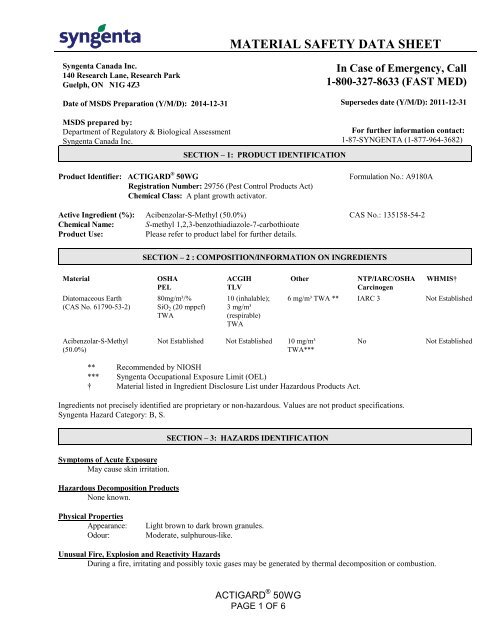
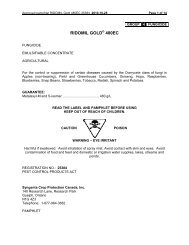
![gesagard 480sc [pamphlet] - Syngenta Crop Protection](https://img.yumpu.com/50945984/1/190x245/gesagard-480sc-pamphlet-syngenta-crop-protection.jpg?quality=85)
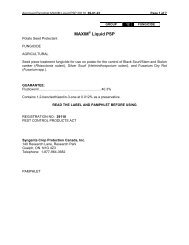
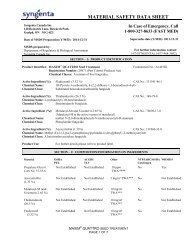
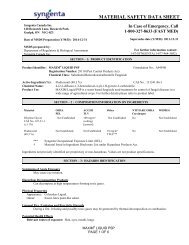
![ridomil Gold mz 68wp [bag] - Syngenta Farm](https://img.yumpu.com/49025229/1/190x245/ridomil-gold-mz-68wp-bag-syngenta-farm.jpg?quality=85)
